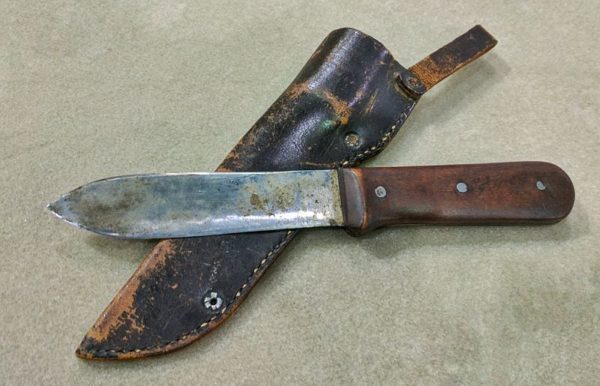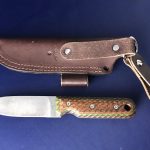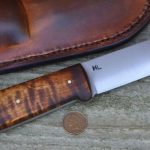(This site is reader-supported. When you buy something using retail links on our articles, we may earn a small commission. As an Amazon Associate I earn from qualifying purchases.)
There are numerous types of knives, of which many have bizarre names. While some knife names are weird, a few are such that they seem to be without any sense. So, what is in the name? Well, the name itself has the full story of evolution to tell.
At times, knives carry the name of its creator or the name of the person who carried it. Some of these names are Bowie, Kephart, and Nessmuck. In this post, we discuss what a Kephart knife, its origin, and the modern equivalents.
>>Click here to find out our favorite Kephart knife on Amazon
Origin of Kephart Knife
Source: Truthaboutknives.com
Kephart knife was the brainchild of Horace Kephart, who was born in East Salem, Pennsylvania, and brought up in Iowa. He was a trained librarian whose expertise was in Biology and Natural Sciences. He also had a profound love for writing.
However, by early adulthood, Horace had written comprehensively about his craze for the outdoors, camping, and hunting. Nevertheless, the urban reality between camping journeys started to affect him. As a result, he set for the western North Carolina mountains in 1904 and introduced a course for having nature as the healer for his lifestyle.
Kephart was an expert in living on his own with just a few gears while being far from civilization. He passed his knowledge by writing about his tasks and inventions in the wilderness. Kephart also wrote about how to use the primary tools and how to make a shelter to survive.
His primary weapons or tools along the journey and in provisional camps were a small tomahawk with a handle of one-foot long (hatchet), a fixed-blade knife, and a jackknife kept in a pocket with one 3-inch long blade.
The hatchet was moveable and easy to carry in a pack. Still, the size was big enough to treat wood for making fire as well as shelter. On the other hand, the jackknife had smaller blades due to which it was ideal for whittling and smaller cutting jobs.
The fixed-blade tool was a belt knife useful for most significant cutting tasks, ranging right from the wood to cooking. Far from base camp, this arsenal was enough to keep him protected and comfortable during his trips.
It was the fixed-blade tool that is known today as the Kephart knife. The creator, as the author, has described this knife in detail.
Modern Kephart Knives in the Market
Between the customer and budget models, a Kephart blade exists to fulfill your requirements. Even after 100 years, the Kephart knife is considered a classic piece just because it performs so well.
At present, a few different Kephart knives are available. They are not the original Kephart designs, as there are a few changes introduced in them. Following are some of the modern Kephart knives:
Battle Horse Bushcrafter, weighing 7 oz and having a flat-ground model, a 4-inch blade being 0.15-inch thick and having a satin finish, a distinct finger groove ensuring a minimal guard, a wrist lanyard hole, and classy brown scales with no hotspots; available even in saber and Scandi grinds, as well as different micarta, handles
Condor Tool & Knife, Kephart Knife, as a 3.5-ounce model made using 1075 high-carbon steel and featuring a flat-ground, spear-point blade, a walnut handle, even but unpolished grind lines, and no hotspots; easy to sharpen but to hold an edge for a shorter time than 1095 steel.
Lucas Forge Kephart made by Lucas Bullington in Alabama to be the closest replica of the original Kephart pattern and having forged tool steel blade that is 4.5-inches long oxidized to resist corrosion, finished walnut handle, and a leather sheath
Matt Lesniewski (ML) Kephart, as a highly-functional field knife forged and ground manually using the durable and tough 1095 high-carbon steel and having a soft spine and a hard edge to resist abuse, an 8.43-inch dark blade that is 0.13-inches thick, a 4.25-inch handle, smooth black walnut scales, and a fine micro bevel
Best Kephart Knives on Amazon
Here is the list of top Kephart knives available on Amazon.
| Image | Title | Price | Amazon Page |
|---|---|---|---|
Top Top
Top | KA-BAR Becker Kephart Fixed 5.1 in Blade | Check Price on Amazon | |
 Top
Top | Camp Lore PR-4 Black Oxide | Check Price on Amazon | |
 Top
Top | Condor Tool & Knife, Kephart Knife, 4-1/2in Blade | Check Price on Amazon | |
 | Ontario Fixed 4 in Blade Wood Handle | Check Price on Amazon | |
 | ESEE PR4 Fixed Blade Survival Knife | Check Price on Amazon |
Description of Kephart Knife by the Creator as an Author
Kephart was a creative writer. He wrote touchy documentation on mountain culture and his inputs to camping and woodcraft. During this time that was the early time of the 19th century’s first decade, the Americans were giving rise to the conservation idea due to which the subjects related to the national parks were in a public conversation.
It was the perfect time for Kephart to publish, ‘Camping and Woodcraft,’ which gave practical advice about the outdoors to the readers. In the first edition of this composition, he has described his knife.
According to this book, the Kephart knife featured a 4.25-inch long handle as well as a blade. The blade was an inch wide and 1/8-inch thick at the rear, was broad-pointed, and passed via the handle and was riveted to it.
The blade was tempered hard such that it could cut those hardwood sticks. However, it was soft enough to restore its order if it moved instead of cutting a knot or bone.
The light, hardwood handle featured an oval cross-section and is sufficiently long to ensure proper grip for the whole palm and fingers. There were no sharp edges to harm one’s hand. It came with a 0.25-inch knob acting as a guard at the rear of the cutting edge. However, no guard existed on the back, as it would merely come in the way.
At the butt, the handle was 0.75-inch thick and tapered to hand-inch forward for effortlessly penetrating the sheath and gripping it firmly. If it were heavy, it would result in a fall while stooping over. The weight of this knife was just 4 ounces.
According to Horace Kephart, “It was made by a country blacksmith, and is one of the homeliest things I ever saw, but it has outlived in my affections the score of other knives that I have used in competition with it, and has done more work than all of them put together.”
Kephart loved this knife so much that he also played a vital role in its promotion. Pennsylvania’s Colclesser Brothers firm provided its commercial versions featuring 4 to 5-inch long blades and a two-piece fitted belt sheath or leather at an affordable price. Other firms sold similar patterns for many years.
The makers of knives today continue to design on the Colclesser-Kephart, as the Kephart design is widely regarded as a superb bush crafter featuring a spear-point stemmed from the esteemed Dadley pattern.
However, in the 1917 edition of the composition, Kephart indicated that another blade had resulted in a twist. While he illustrated the knife, he did not reveal the maker or the model.
The historical experts believe that Kephart accentuated the Woodcraft due to the pressure from George W. Brooks, who was the publisher of the composition and designer of the knife. However, the traditionalists strongly believe that Kephart always favored his own-designed knife.
This was also what the curators at Mountain Heritage Center of Western Carolina University endorsed upon gathering in a 2004 exhibit commemorating the Platinum Jubilee of Kephart’s journey to western North Carolina. Here, the only sheath knife showcased was the spear-point Kephart.
The Design
At present, there is no universal design or pattern for this bushcraft knife. It is a plain cutting knife with a broad pointed tip and is designed for outdoor buffs such as hunters and campers. It is a striking hardwood tool having big dimensions.
In its purest form, this knife is meant for utility. The 4.25-inch blade is more than sufficient for skinning deer, carving wood, and cooking in cabins and provisional settings such as tents, without giving an awkward or too long feeling while performing finer cutting tasks.
The blade also consists of a thin, flat, and full grind to supports a sharp or fine cutting edge. The spear-point that is overly pointed is made for removing the elk’s or deer’s hide without piercing the tissues underneath. There is also ample belly for use in the kitchen of a camp.
The knife’s tip is sturdy. The cutting edge spreads up to the rear and slabs of the wooden handle. It means that there are no unwanted choils or wasted blade space.
A small guard repels to the efforts that a forefinger takes to glide forward onto the edge. This finger guard is typical to the design of this knife and protects your fingers at the time of use.
The strength comes from the full tang profile. The handle’s oval cross-section is comfortable and has no unsafe spots to result in blisters when used for a prolonged period.
This cross-section design is seen in very few knives. It is sufficiently long to encompass the blade size for a great gripe. The blade is typically made using the carbon steel material. This material was among the most popular ones when Horace Kephart first made this knife.
This material is quite strong and embraces high pressure. However, its popularity is exhausted due to the introduction of stainless steel. Still, many prefer carbon steel over this popular steel material, as it provides relatively a more precise cut.
The Kephart knife also usually has a sheath. The historical records have revealed that Horace Kephart was spellbound by looking at the Sear design and work of George Washington. Thus, he employed the same pure leather for making a sheath for this knife.
At 4 ounces, the knife is both light and big enough to carry throughout the day and perform a variety of tasks, respectively.
Kephart Knife: From the Horace Era to the Modern World
During the Kephart’s era, the modern uses or potentials such as batoning and chopping were mostly unfamiliar when it comes to buying and using an outdoor knife.
Working knives were used to cut things that required only cutting, not splitting, or chopping. For the latter tasks, axes were in use, which is why Horace had kept one ax (tomahawk) in this arsenal while on the trail.
The Kephart design is still in use and is available in a variety of materials and costs. It also has different interpretations that differ from near replicas to roughly inspired versions that change in terms of blade profile or grind.
It is still not clear as to which type of steel did the Kephart’s blacksmith use to make the knife. However, the pattern that is now in use is quite improved, even if it is a basic form having high-performance steel as well as a handle material.
Conclusion
The Kephart is a beast in the wild and a workhorse, which can do anything in the outdoors. Its design is now in the models of many makers. This is because the design is responsible for its lasting legacy that has endured all the trends in survival gear. It is tested, and its functionality is abiding. While it is difficult to get the original pattern, a modern form can still be enjoyable when you carry it as a historical piece.

Hi, I am Jay. I am the creator of Knife Guides, your one-stop site for everything related to knives. I am a computer engineer by profession, knife aficionado by passion. Here I work with a group of people who’ve always had a passion for knives and blades. Over the years we’ve kind of become experts and decided to share our knowledge and ideas. I am also an avid hiker and enjoy offshore gamefishing.


 Battle Horse Bushcrafter, weighing 7 oz and having a flat-ground model, a 4-inch blade being 0.15-inch thick and having a satin finish, a distinct finger groove ensuring a minimal guard, a wrist lanyard hole, and classy brown scales with no hotspots; available even in saber and Scandi grinds, as well as different micarta, handles
Battle Horse Bushcrafter, weighing 7 oz and having a flat-ground model, a 4-inch blade being 0.15-inch thick and having a satin finish, a distinct finger groove ensuring a minimal guard, a wrist lanyard hole, and classy brown scales with no hotspots; available even in saber and Scandi grinds, as well as different micarta, handles
 Matt Lesniewski (ML) Kephart
Matt Lesniewski (ML) Kephart